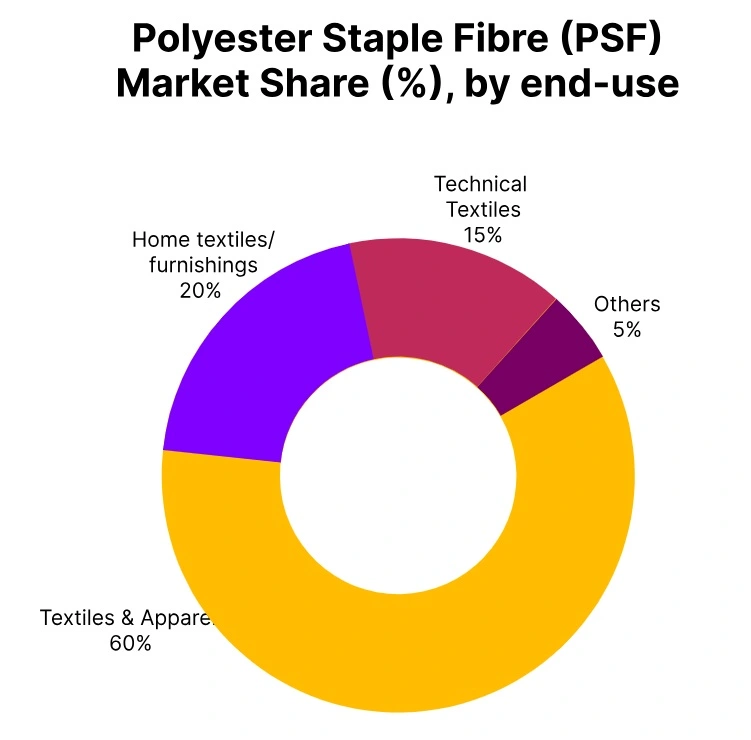Price-Watch’s most active coverage of Polyester Staple Fibre (PSF) price assessment:
- Thickness 1.2 D/Length 38 mm Semi Dull White Ex-Mumbai, India
- Thickness 1.4 D/Length 38 mm Semi Dull White FOB Shanghai, China
- Thickness 1.4 D/Length 38 mm Semi Dull White CIF Chittagong (China), Bangladesh
- Thickness 1.4 D/Length 38 mm Semi Dull White CIF Haipong (China), Vietnam
- Thickness 1.4 D/Length 38 mm Semi Dull White CIF Jakarta (China), Indonesia
- Thickness 1.4 D/Length 38 mm Semi Dull White CIF Santos (China), Brazil
Polyester Staple Fibre (PSF) Price Trend Q3 2025
During Q3 2025, the global Polyester Staple Fibre prices experienced an increasing trend by around 1–3%, driven by higher feedstock costs, increased demand from textiles and nonwovens, and varying regional freight impacts. Polyester Staple Fibre (PSF) price trend in September 2025 reflected improving domestic consumption, seasonal restocking, and resilience in downstream sectors such as apparel and home textiles. Differential freight and currency movements across continents contributed to variations in price growth.
India
Polyester Staple Fibre (PSF) Domestic prices Ex Mumbai, India; Grade- Thickness 1.2 D/Length 38 mm Semi Dull White
According to Price-Watch, polyester staple fibre price in India displayed a firm upward price trend in Q3 2025, rising by 3–4% compared to Q2. The Polyester Staple Fibre price trend in India owed much of its strength to robust demand from textile mills, furniture, and nonwoven segments, with steady restocking encouraged by expanding festival season consumption and solid PET resin input costs.
Market growth outpaced recent quarters, as local infrastructure investment and more consistent ordering buoyed both manufacturer margins and market sentiment. In September 2025, Polyester Staple Fibre prices in India stabilized in the USD 1100–1200 per metric ton band, sustained by heightened procurement and resilient local end-use demand.
China
Polyester Staple Fibre (PSF) Export prices FOB Shanghai, China, Grade- Thickness 1.4 D/Length 38 mm Semi Dull White.
Polyester Staple Fibre price in China advanced about 1% in Q3 2025, solidifying a positive quarterly price trend. The Polyester Staple Fibre (PSF) price trend in China was shaped by consistently strong export orders from textile and spinning sectors, bolstered by stable PET raw material pricing.
Extended production schedules and the re-emergence of seasonally driven export opportunities aided ongoing sectoral expansion, giving sellers confidence in market outlook. In September 2025, Polyester Staple Fibre export prices in China moved to the USD 890–1000 per metric ton range, with efficient supply chains, global demand strength, and favourable logistics supporting a constructive market tone.
Bangladesh
Polyester Staple Fibre (PSF) Import prices CIF Chittagong, Bangladesh, Grade- Thickness 1.4 D/Length 38 mm Semi Dull White.
Polyester Staple Fibre price in Bangladesh climbed by 2.5–3% in Q3 2025, keeping up a healthy upward price trend for the period. The Polyester Staple Fibre (PSF) price trend in Bangladesh was a function of robust order flow from apparel and home textile producers in tandem with a freight hike that increased landed costs for importers.
Procurement activity stayed firm as local buyers responded to price risk by securing supply against ongoing global logistics uncertainty. In September 2025, Polyester Staple Fibre prices in Bangladesh continued rising, reflecting resilient downstream consumption and persistent freight challenges.
Vietnam
Polyester Staple Fibre (PSF) Import prices CIF Haiphong, Vietnam, Grade- Thickness 1.4 D/Length 38 mm Semi Dull White.
Polyester Staple Fibre price in Vietnam went up by 1% in Q3 2025, resulting in a generally constructive price trend. The Polyester Staple Fibre (PSF) price trend in Vietnam owed its moderation to steady freight rates and solid end-use demand from garment and textile industries.
Strategic restocking by mills and expanding domestic fabric production facilitated incremental market gains. In September 2025, Polyester Staple Fibre prices in Vietnam showed a balance of secure supply and growing downstream orders, with stable to positive pricing through the period.
Indonesia
Polyester Staple Fibre (PSF) Import prices CIF Jakarta, Indonesia, Grade- Thickness 1.4 D/Length 38 mm Semi Dull White.
Polyester Staple Fibre price in Indonesia stayed generally flat across Q3 2025, as the downward drift from Q2 evened out due to more favorable freight rates. The Polyester Staple Fibre (PSF) price trend in Indonesia underscored competitive global supply and cost-efficient sourcing options, keeping price fluctuations minimal.
Spot procurement and ongoing buyer caution became central themes in market behavior, as buyers waited for clearer demand signals amid shifting logistics costs. In September 2025, Polyester Staple Fibre prices in Indonesia saw limited movement, with persistent restocking discipline preventing unnecessary price volatility.
Brazil
Polyester Staple Fibre (PSF) Import prices CIF Santos, Brazil, Grade- Thickness 1.4 D/Length 38 mm Semi Dull White.
Polyester Staple Fibre price in Brazil surged 4–5% in Q3 2025, marking a robust upward price trend for the quarter. The Polyester Staple Fibre (PSF) price trend in Brazil responded to freight cost escalation and robust buying sentiment, with furniture, textile, and industrial nonwoven users accounting for most incremental order activity.
Market resilience stood out despite global supply constraints and higher landed costs, as buyers retained confidence by accepting greater supplier quotes. In September 2025, Polyester Staple Fibre import prices in Brazil signalled persistent supply pressure and strong downstream demand, prompting the acceptance of further price increases.





